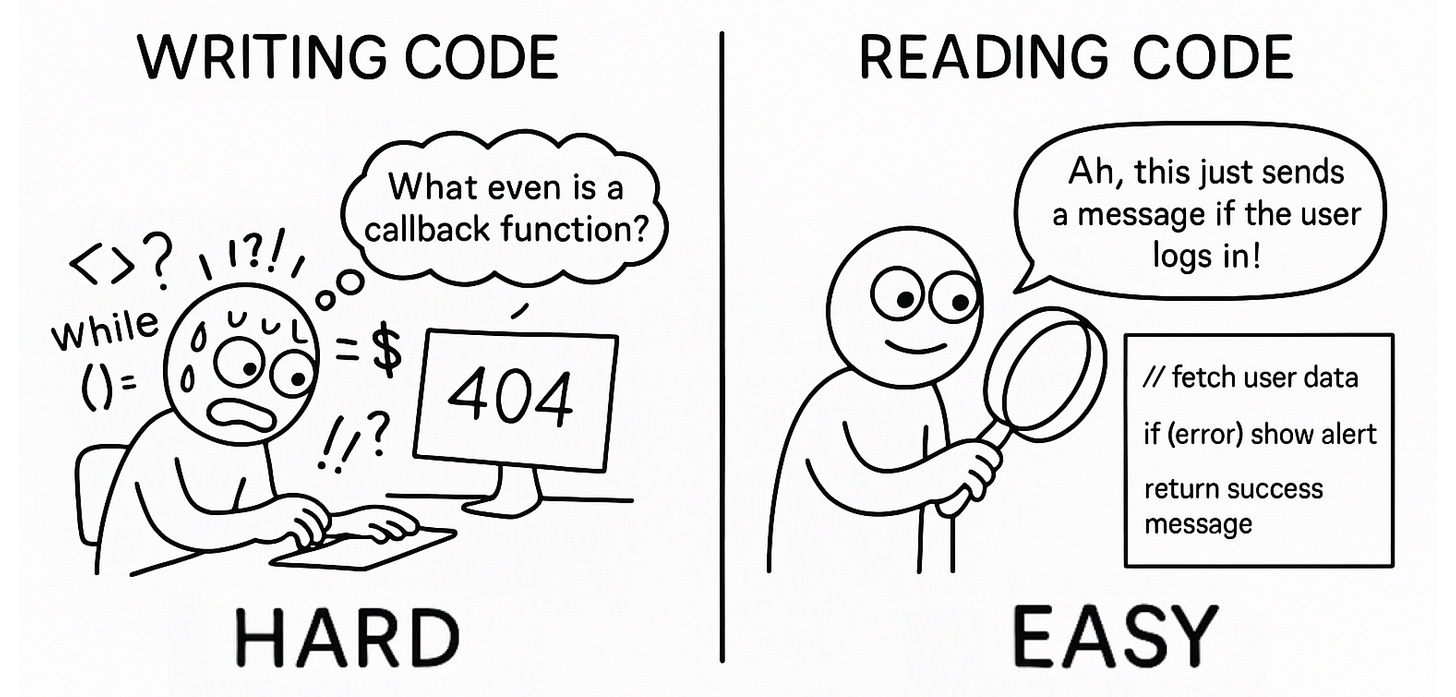The illusion of vibe-coding and why vibes aren't enough
3 reasons why you're vibe-coding wrong, and 3 ways to do it right!
These days, the market is flooded with AI code assistants, co-pilots, and so-called "vibe coding" tools. They all promise the same thing: the ability to build full-stack applications with zero technical skills.
To someone without a technical background, that sounds like a dream. Why wouldn’t it? Just type in a few prompts and boom, you've got a working app! No coding knowledge required.
But here’s the uncomfortable truth: these bold promises are part of a slick marketing campaign to get you to buy their subscription packages. The reality of this technology is much less impressive. If you’re paying for these tools expecting them to do your technical heavy lifting, you’re wasting your money.
I know, because I’ve been there too. As a non-technical founder turned engineer, I’ve been on both sides. I fell for the same promises and believed I could pay for a shortcut and "vibe-code" the technical bits.
So this article isn’t for developers or engineers, it’s for the non-tech founders, the “idea people,” the builders trying to bring something to life without writing code. If that’s you, let me explain why vibe coding is an illusion that wastes your money and time, and what you could do instead.
Sections
Vibe-coding a house: An Analogy
What you say, not what you mean
Building rubbish on top of rubbish
Can't fix what you don't understand
How to vibe code the right way
Learn how to read code
Learn infrastructure
Modular approach
Vibe-coding a house: An Analogy
We're going to explain the issue with vibe coding with a simple analogy: building a house.
Let's say you're married, have two kids, and need a house for your family. You think you'll need three stories and a backyard, and your kids also really like the colours pink and blue. With this in mind, you go to ChatGPT and say: "Build me a three-story house with a backyard. I want the walls to be a mixture of pink and blue"
ChatGPT builds you a house and all seems fine... Until you open the front door and realise there are no walls or furniture.
What you say, not what you mean
The first big problem of vibe coding with AI is that it does exactly what you say, not what you mean.
Sure, the house is pink, blue, and has a backyard, but walk inside and it's just vibes. No walls, no furniture, not even a toilet. Turns out, if you don't spell out every detail, AI will miss critical details that seem intuitive to you and me, leaving you with something that works in appearance but not in practice.
In real cases, you might tell Co-pilot to “Make a to-do list app,” and the AI gives you something that looks amazing, nice buttons, a sleek design, the whole package. But the moment you close the app, everything disappears. Why? Because you didn’t tell it to save the tasks, even though it's something pretty intuitive.
But I hear you say, "Fine! But I’ll just keep prompting it until it becomes a fully functioning app!"
There are two problems with that approach. First, if you have no technical knowledge, there will be crucial things that you won't know to ask for. Using the house example, if you were vibe-building your house, would you remember to ask for wall insulation? Probably not. It's a crucial part that keeps the house warm, but you don't see it so you don't ask for it. Then come winter, you're shivering and wondering why your AI-built home feels like a fridge.
Same with apps. Things like authentication, error handling, rate limiting, secure API practices, and database indexing are taken for granted if you've never had to think about them. But they play a crucial role in your infrastructure, and could collapse it if done poorly.
I remember one time I asked Cursor to write an API call for me. The code it wrote worked, but it wrote the API call on the frontend, effectively exposing my secret keys. If I were non-technical, I would've called it a day, pushed it to production, and woken up the next day to an empty Stripe account because someone stole my keys.
But arguably worse is the second problem: When you start building rubbish code on top of rubbish code.
Building rubbish on top of rubbish
Iteration is the most important thing in development. No product is built perfectly from the get-go. All products must continuously build on top of themselves to fit the demands of the market.
With vibe-coding, your only means of iteration is writing prompts to tell your agent what to do, especially if you can't read code. Let me demonstrate the problem with that using our house-building analogy again.
Your request was fulfilled, and you technically got what you asked for. However, ChatGPT didn't add structures like a support beam to hold up your new floor and balcony. It just built on top of what's already there, thus leaving a very unstable and dangerous building.
The same thing will happen if you ask AI to build you features without considering your infrastructure. Say you vibe-coded a Twitter copy where your users can post text updates. You then requested co-pilot to build a video uploading feature. It builds it, the app looks fine... and then out of nowhere, your whole app crashes.
Why? Because ChatGPT built this new feature using your old setup without upgrading anything behind the scenes. Video uploads need more storage, faster servers, and better traffic handling. But none of that was added. So, although you technically get the feature, without the infrastructure to support it, it’s like adding a hot tub to the glass roof of a garden shed.
Most likely, when this happens, you won't know what went wrong or how to fix it, which leads us nicely to the last problem.
Can't fix what you don't understand
When you don't understand the code you're building, you also don't understand the mistakes you're making. And when something inevitably goes wrong, you have no clue how to trace the problem, let alone write a fix. Worse, the code AI writes is almost never clean or logical. It might work, but under the hood, it's often a tangled mess.
But I know what you're thinking. "I'll ask or hire a technical person to fix it."
Oh dear… I remember multiple occasions where some of my non-technical friends vibe-coded a product using AI, ran into a bug, then handed me their code and said: “Can you just fix it?”
My genuine reaction:
If you're a dev, you can probably relate.
There seems to be an assumption that you can just vibe-code something with ChatGPT, and if it breaks, a developer can jump in and magically pick up where you left off.
But that’s not how it works.
Asking a dev to debug that is like asking an electrician to fix a broken light in a house where the wiring was done by an AI. Imagine if you had to figure out why the last lightbulb isn’t lighting up. It’d be a nightmare.
Not understanding your code is the biggest danger of vibe coding because you’re building things you can't maintain.
And when things break—which they will—you’ll either be stuck, or left paying someone to rebuild what you thought was already finished.
How to vibe code the right way
I've thrown a lot of shade on vibe-coding, but it has its place and value. Used well, it can be a powerful way for non-technical people to prototype, explore ideas, and move fast without waiting on engineers. Here are a few things you can do to vibe-code the right way.
Learn how to read code
By far the most important step. You don't have to be good enough to write good code, just good enough to read and understand. Think of it like reading sheet music. You don’t need to compose a symphony, but if you can follow along, you’ll spot when something’s off-key.
Being able to read code means:
You can debug small issues on your own.
You’ll catch it when the AI outputs something sketchy.
You’ll write better prompts with specific instructions that are less likely to produce unintended side effects.
I recently wrote a guide for non-technicals getting into tech, where I walk through exactly how to get started. If you're interested in learning how to code, I highly recommend reading that.
Learn infrastructure
Most non-techs ignore infrastructure completely, but it’s the key to making your product stable, fast, and scalable.
Here are a few key things you should know:
The difference between frontend, backend, and database
What servers do
Basic hosting and deployment
Knowing this helps you plan properly when building features. For example, “Can I just add video uploads?” becomes “Do I have storage? Do I need compression? Will this crash my app?” Having a mental model of your infrastructure will help you mitigate foreseeable problems.
Modular approach
One of AI’s biggest strengths is writing small, self-contained chunks of code, and NOT architecting an entire app from scratch. That’s where most vibe coding goes wrong, asking ChatGPT to “build me a whole social networking app”.
Instead, use a modular approach to vibe-coding. Break your idea into pieces. Ask your co-pilot to build:
A form component
A specific function
An API call
This way, when things go wrong, you’ll have a much easier time tracing the issue to a specific piece of the puzzle instead of staring at a 3,000-line blob of mystery code.
Modular coding is also way easier to hand off to real developers later. Trust me, they’ll thank you.
Closing Notes
The bad news and good news is that AI is currently terrible on the conceptual front of programming (design, infrastructure, etc.).
It's bad news because it’s not yet possible for a non-technical person to build a full-stack production-ready app entirely on their own using AI.
It’s good news because we developers still have jobs. But once AI advances to a point where it can write AND design code, you'll see me at McDonald’s putting your fries in the bag.
In the meantime, vibe coding is still a great way to start building. Use it to test ideas, move fast, and explore. But don’t mistake a prototype for a product. Otherwise, you’ll be standing in your pink-and-blue dream house wondering why the toilet doesn’t flush, the roof’s on fire, and your Stripe account’s been emptied.
Learn enough to steer the ship, and be ready to rebuild it when it starts sinking.
Share your thoughts!
Did I miss anything? Was I too harsh on vibe coding? How do you use AI tools when building?
I’d love to hear your experience, whether you’re a non-tech trying to ship your first idea or a dev who's cleaned up a few too many AI messes.
Drop your thoughts below!
I hope you have enjoyed reading and taken away something useful from this article! Please consider subscribing to my Substack! I write frequently about tech and lifestyle :)
If you think your friend might enjoy what I wrote, please send it to them!
If you’d like to reach out, you can message me on LinkedIn or email me at remuspoonbusiness@gmail.com. Have a wonderful day!












